Should You Squat With a Belt?
Author:
Unlock your full potential by engaging with our experts and community! Have questions about your fitness journey or looking for expert advice on weightlifting techniques? Don’t hesitate — leave a comment below and Ihor Shymechko will provide a personalized answer and insights to help you reach your goals.
Torokhtiy is reader-supported. Some links are affiliate links, and we may earn a commission at no extra cost to you. See our disclosure page for details.
You’ve likely seen many people at the gym squatting with a belt. And that might have led you to wonder, “Should I wear a belt when squatting, too?”. And in this article, we will help you find the answer to the question by yourself.
We will be discussing all the benefits that come with using a belt for squats and also how to choose the right belt for you, depending on the type of workouts you do.
Should You Be Squatting with a Belt? – Yes, if you’re lifting heavy weights. It will help you improve your biomechanics, reduce the stress on the spine and prevent future injuries.
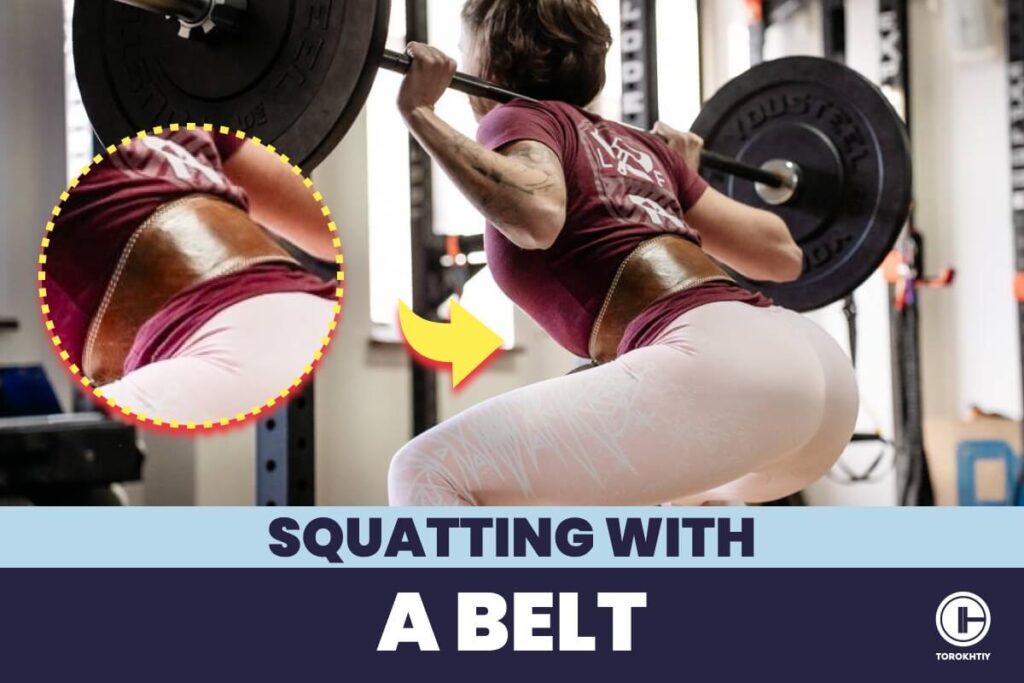
What Does Wearing A Lifting Belt Do and Do Not During Squats?
Beginner lifters often don’t know precisely why lifting belts for squats are used, and so they tend to ask, “ What does a belt do for squats.” Fortunately for all of us, this question has an easy and straightforward answer.
Wearing a lifting belt when squatting with heavy weight helps prevent injuries, lowers the stress on the spine, improves the biomechanics during the movement, and provides you with extra support, which for most lifters results in more confidence that they can deal with the desired weight.
That is why, when you see people at the gym squatting with really heavy weight, they’re wearing belts in most scenarios. On the other hand, if you’re not squatting with a ton of weight and you’re doing a more HIIT-style workout, wearing a lifting belt is absolutely unnecessary.
Along with that, even if you’re lifting heavy, but you’re doing isolated work on shoulders, biceps, triceps, or quads, you don’t need to wear a belt, as your spine is not under load and not experience shearing forces and there is no need for extra support you would not be able to handle by yourself. So you don’t need that extra support.
3 Key Benefits of Wearing a Weightlifting Belt in Squats
As you can already see, wearing a belt has many benefits when doing squats. However, most lifters only use a belt because of three main benefits that will be discussed at length below.
✅ Prevent Injuries
Heavy weightlifting puts a ton of stress on the body, not only on the muscle tissues but also on the spine and on all the joints that are used during the main exercises (squat, deadlift, bench press, etc.). Because of that, injuries tend to occur, and in most cases, lifters are trying to do everything in their power to avoid that scenario.
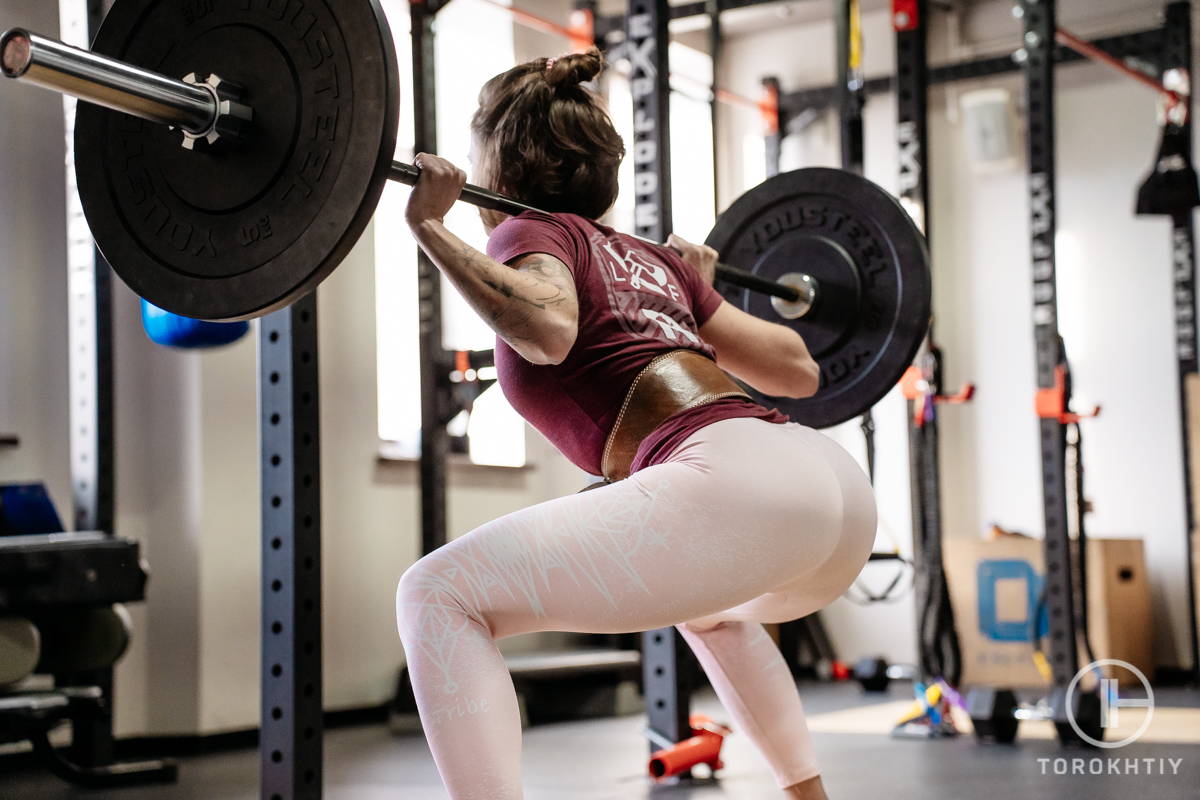
When wearing a belt, you can prevent serious injuries (not all unfortunately) from happening when you’re under a heavy load. That’s because the belt gives your spine extra support, helps you maintain proper form, and makes sure you’re engaging your core muscles during the lift.
The combination of those three things ensures that you’re moving in the best way possible, even when lifting close to your one-rep maximum. Many specialists argue that using a belt is a necessity for lifters who squat or deadlift two times their body weight or more.
Otherwise, that kind of weight put on the spine can lead to serious damage, mainly if the exercises are also performed with incorrect form.
✅ Reduce Stress on the Spine
Should you squat with a belt? Yes, if you’re lifting heavy and you want to keep your spine injury-free. Studies have already confirmed that wearing a weightlifting belt can increase intra-abdominal pressure by around 50%, and you can think of that increased pressure as a balloon that’s getting inflated inside your abdominals.
Now you might think that doesn’t sound good at all, but it’s, in fact, super helpful. Thanks to the increased inside pressure, the spine gets support from the inside. That pressure and your muscle armor helps keep the spine more stable and thus reduces the stress it’s subjected to during heavy weightlifting.
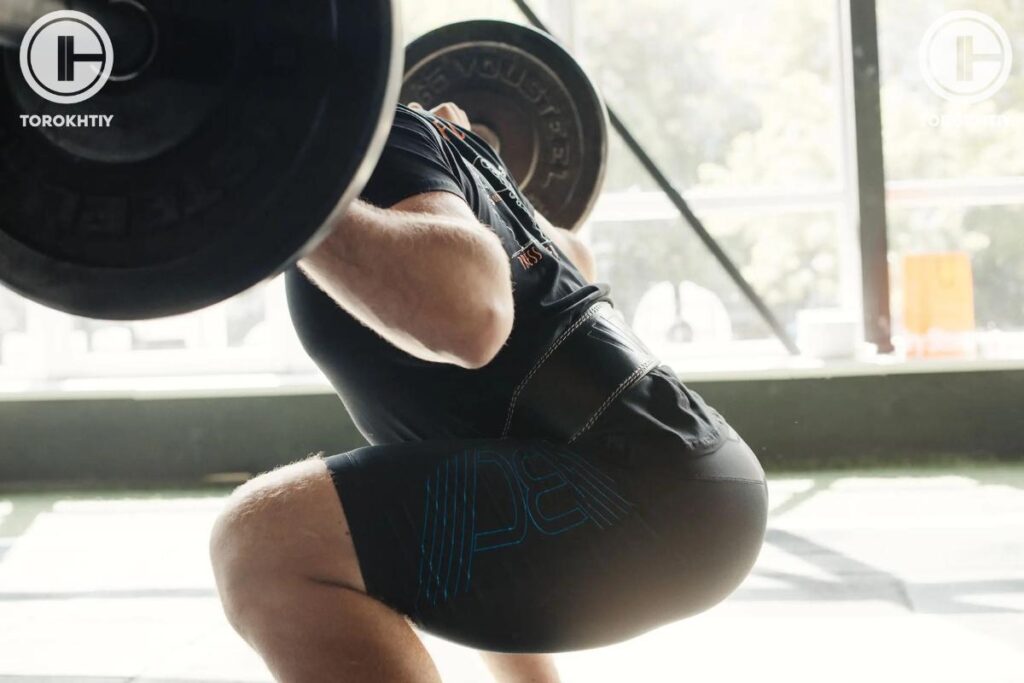
✅ It helps Improve Body Biomechanics
According to research, wearing a lifting belt when deadlifting box off the ground reduces the amount of spinal extension, flexion, as well as lateral spinal flexion. At the same time, it’s shown to increase flexion at the knees and hips.
In simpler words, wearing a belt when you lift heavy makes sure you’re using your legs to lift and limiting motion of your back – which is exactly what you want to happen when doing a heavy lifting workout.
These are the correct biomechanics for both squats and deadlifts – and by using them, you will be able to perform the exercises correctly and improve your one-rep maxes over time as you build strength in the lower body.
How Do You Use a Powerlifting Belt while Squatting?
Now that we’ve answered the question, “Do you need a belt for squats?” Let’s move on to talking about how to use one when squatting. Below, we will discuss the four steps you need to take in detail so that you know exactly what to do after finding the right belt for you.
Step 1: Locate Your Hip Bone
Once you’ve put on the belt a few times, you will be able to find the hipbone position intuitively; however, the first few times, you will have to consciously think about where it is.
The general rule is that the belt should be placed on the “softer” parts of your core, close to your mid and upper ab area, and not close to any bone. The position can slightly shift so that it’s most comfortable for you, but the middle of your torso is where the belt should usually be.
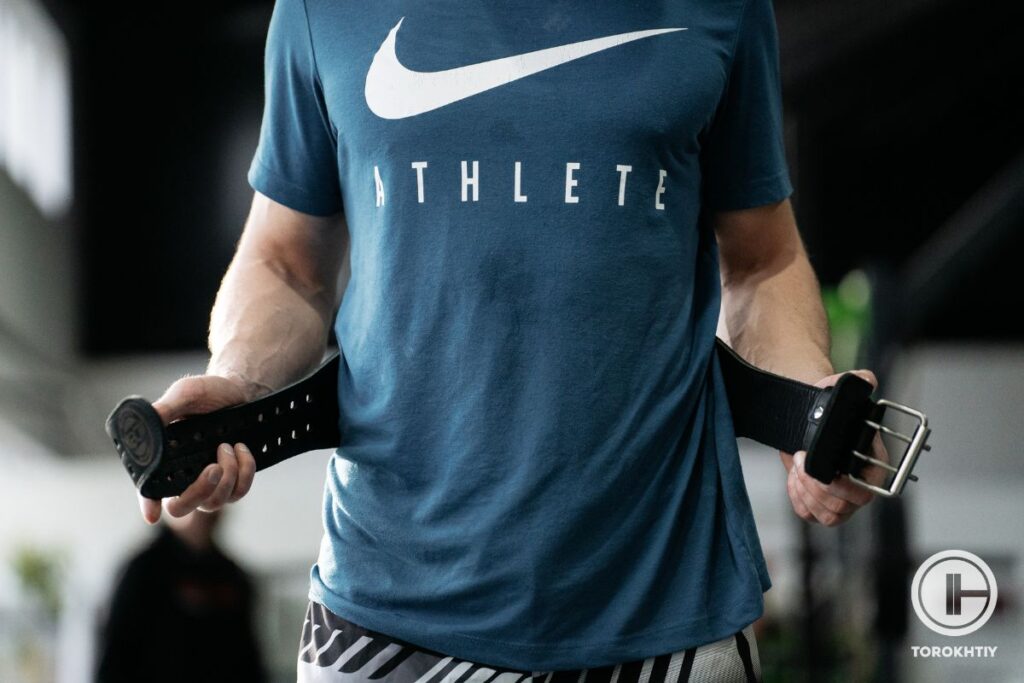
Step 2: Take A Deep Breath
Before locking in the belt, it’s vital that you take one second to draw in a deep breath. That’s because you want the belt to be in a position where it gives you compression and resistance. With that said, you don’t need to vacuum your entire stomach; you just want to take one really big breath in.
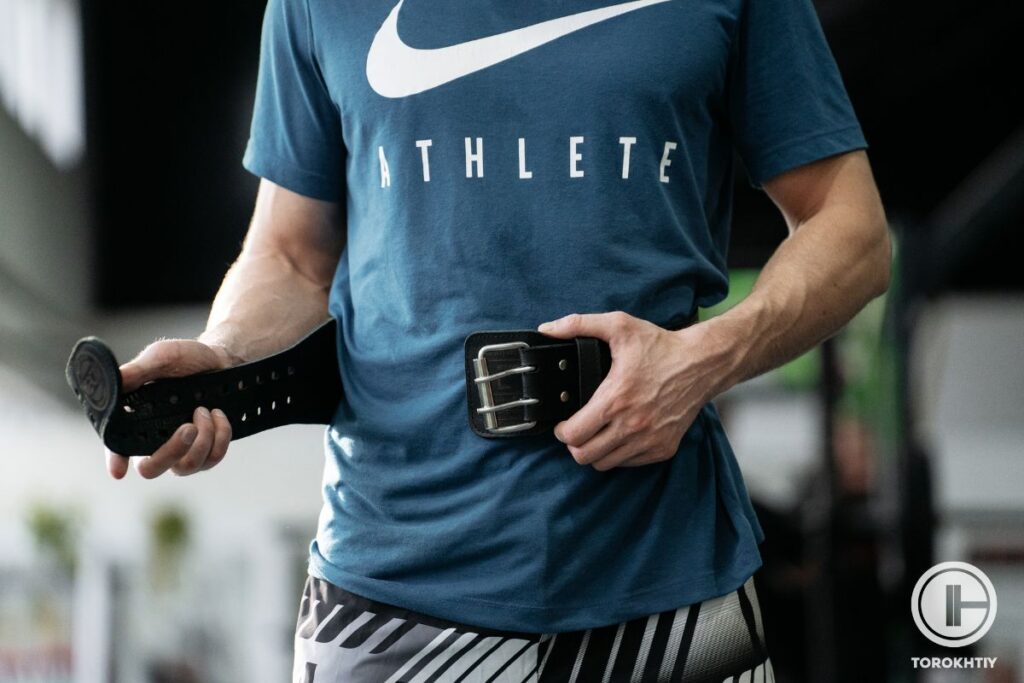
Step 3: Fasten The Belt
Before breathing out, you should fasten your belt, and the way to do that varies, depending on what type of belt you have – some use a prong, lever, or velcro to latch the two sides. It’s vital to remember that there should be some room between your belly and the belt for comfort.
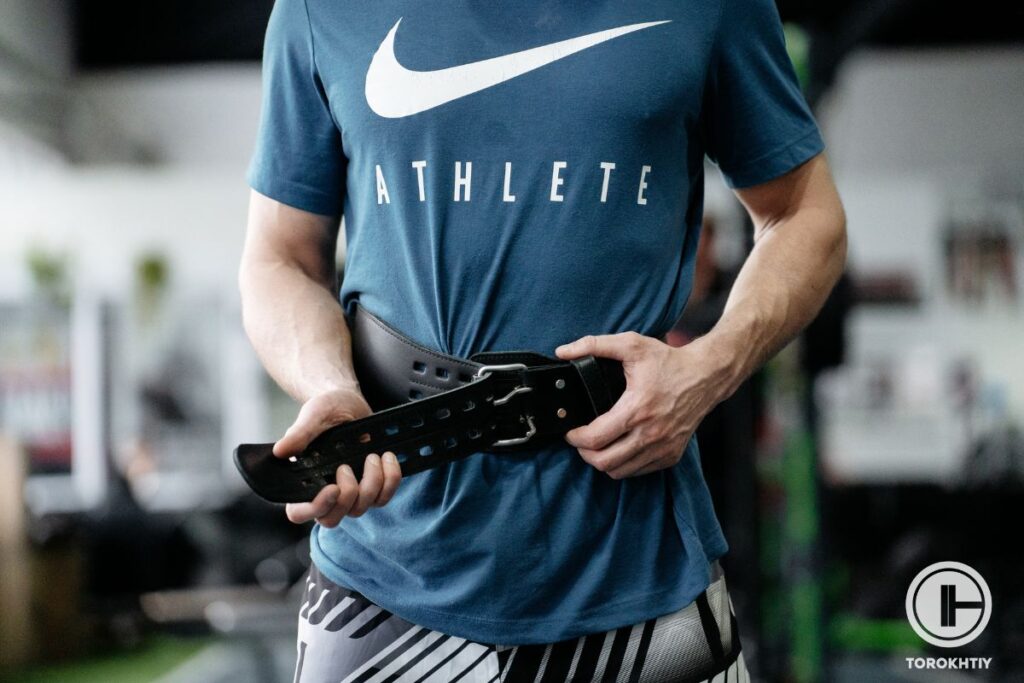
Step 4: Exhale And Check
After you exhale, you want to take a normal breath. The idea is that when you brace your core, tense your abs and inhale – the belt should be tight and prevent excessive expansion. When you breathe out belt shouldn’t be tight and restrict your breathing.
The good rule is that when you’re relaxed you should have space for fingers between belt and your belly/back.
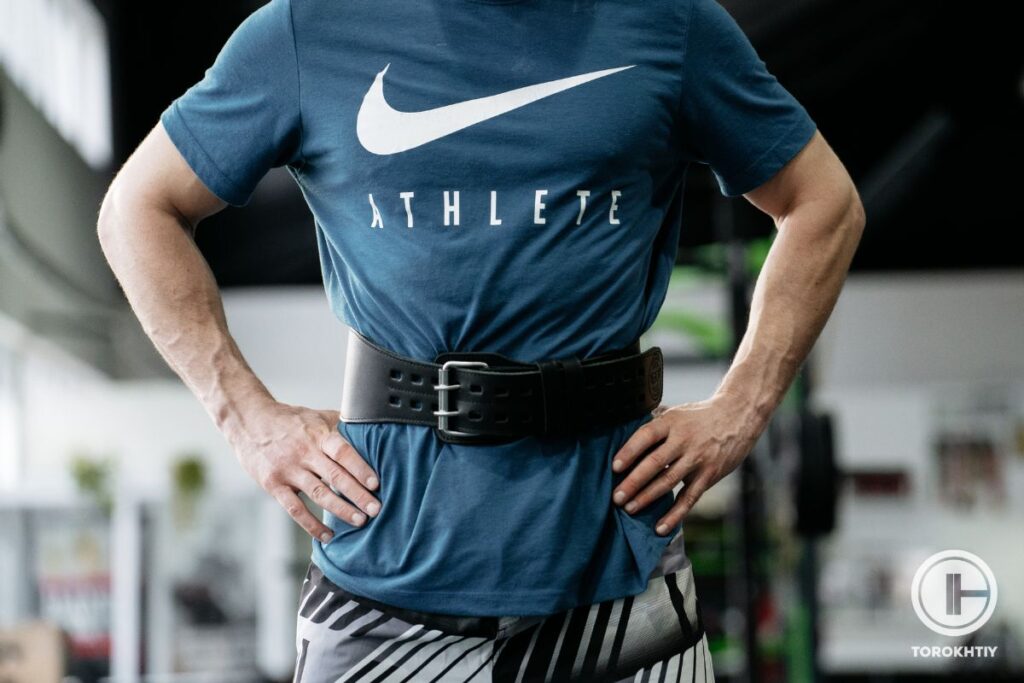
How to Choose the Right Weightlifting Belt for Squats?
There are three main things you need to consider when getting a lifting belt for squats, and they’re:
- Size
- Material
- Buckle
Let’s take a look at them in detail.
1. Size
The two most important measurements are width and thickness. Weightlifting belts usually come in three widths: 4, 3 or 2.5 inches. The biggest ones offer the most support and are preferred by most athletes.
The 3 or 2.5 inches are preferred by people with smaller torsos but actually they are very common across the olympic weightlifters as they are much more comfortable during Snatch and sometimes Clean (shape of the belt you may be familiar with is wide in the back and narrow in the front) , as they’re less likely to dig into the ribs.
When it comes to thickness, most belts are between 9 to 13 millimeters thick. The thicker the belt is, the harder it is to break it in, and that’s why thinner belts are usually more comfortable. With that said, thicker belts offer more support and are more durable.
2. Material
Most belts are made either out of leather or nylon. Leather belts are usually more expensive, more durable, and offer more support. But some athletes prefer to use nylon belts because they feel more comfortable, and your hips can move freely while exercising. They’re also a lot easier to put on and take off, which is vital for fitness-style workouts.
3. Buckle
Belts fall into three main categories, depending on their buckle. Those are:
- Lever belts: These ones are easy to take off or put on; however, if you want to make them tighter, you need to use a screwdriver and reposition the buckle, which is slightly inconvenient for some people.
- Prong belts: There are two types of prong belts: single prong and double prong. The first ones are easier to fasten; however, people prefer the second option as it feels more secure and evenly distributes the pressure on the waist. The only annoying thing about them is that they’re harder to take off or put on.
- Velcro belts: Velcro weightlifting belts are usually made out of nylon and typically feel more comfortable; however, they are not as supportive or as durable as the other variations we discussed.
WARM BODY COLD MIND Leather Weight Lifting Belt
This Warm Body Cold Mind product is a premium leather weightlifting belt made for all kinds of lifters from Olympic weightlifters to Powerlifters and fitness athletes. It’s made out of high-quality material to ensure its durability, and it’s also available in various sizes from S to XXXL.
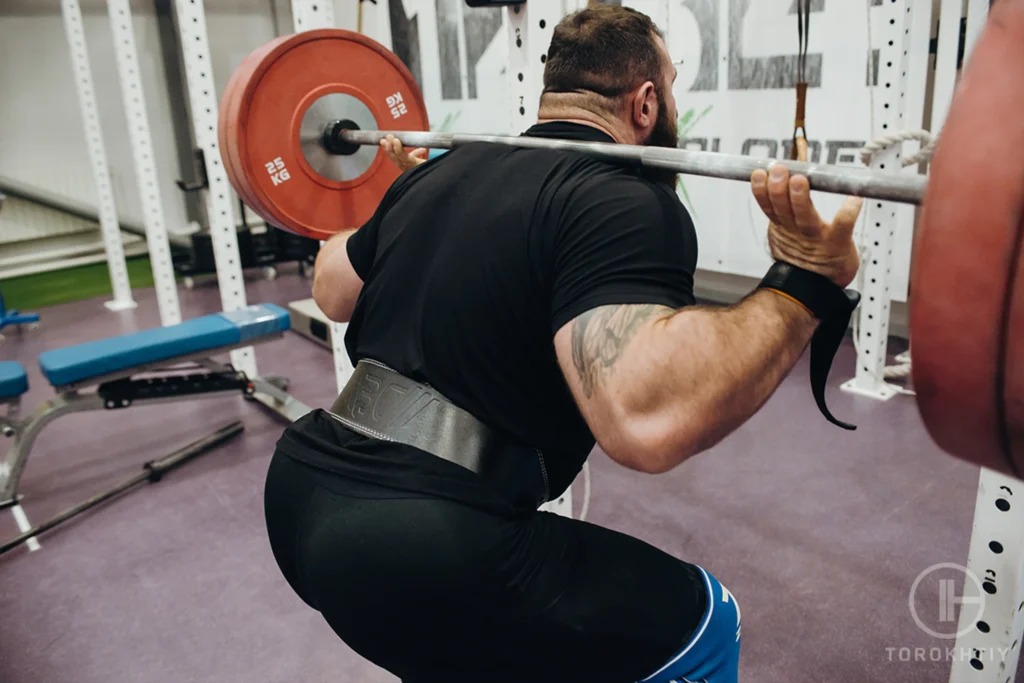
FAQ
Should I Wear A Belt When Squatting?
Yes, if you’re lifting heavy weights and you want to prevent possible injuries and minimize the stress on your spine. Rule of thumb is to put the belt on when you are lifting 75% or more of your 1 rep max.
What Does A Belt Do For Squats?
Using a weightlifting belt for squats ensures you get more support during the movement, may improve biomechanics, lowers stress on the spine, and can be helpful in preventing injuries.
At What Weight Should I Use A Belt For Squats?
The general rule is to start once you begin to lift 2x your body weight or when you’re lifting 75% or more of your 1 Rep Max.
Conclusion
Hopefully, this article helped you understand why wearing a weightlifting belt is helpful and when you should start to do it if you’re frequently lifting heavy weights. And for those who already use a belt, what are the biggest benefits you’ve seen from its use? Let us know in the comments.
Also read:
- Belt For Bench Press
- Best Weightlifting Belt
- Best Lever Belt
- Best Deadlift Belt
- Do You Need A Belt To Deadlift
- What Are Lifting Belts For
- Rogue Lifting Belt Review
- Best Weight Lifting Belt For Women
References:
- Effects of a belt on intra-abdominal pressure during weight lifting // PubMed: https://pubmed.ncbi.nlm.nih.gov/2709981/.
- The effect of wearing a back belt on spine kinematics during asymmetric lifting of large and small boxes // PubMed: https://pubmed.ncbi.nlm.nih.gov/11493853/.
- What Is the Valsalva Maneuver? // WebMD: https://www.webmd.com/heart-disease/atrial-fibrillation/valsalva-maneuver.
- All photos are made by Torokhtiy Media team.
Why Trust Us?
With over 20 years in Olympic weightlifting, strength training, nutrition coaching, and general fitness our team does its best to provide the audience with ultimate support and meet the needs and requirements of advanced athletes and professional lifters, as well as people who strive to open new opportunities and develop their physical capabilities with us.
By trusting the recommendations of our certified experts in coaching, nutrition, and sports training programming, as well as scientific consultants, and physiotherapists, we provide you with thorough, well-considered, and scientifically proven content. All the information given in the articles concerning workout programming, separate exercises, and athletic performance, in general, is based on verified data.
The product testing process is described in more detail here.
Author: Ihor Shymechko
Pro Olympic Weightlifter, Coach
Best Results: Snatch – 208 kg,
C&J – 240 kg
Ihor has been a professional weightlifter since 1996, boasting over two decades of competition experience. His notable achievements include clinching the European Championship in 2009 and securing a silver medal in the 105kg division at the Senior World Championships in 2011. Ihor represented his country in the 2008, 2012, and 2016 Summer Olympics. After retiring from competitive weightlifting, he transitioned to coaching, leveraging his vast experience to guide athletes who now compete on both national and international stages.



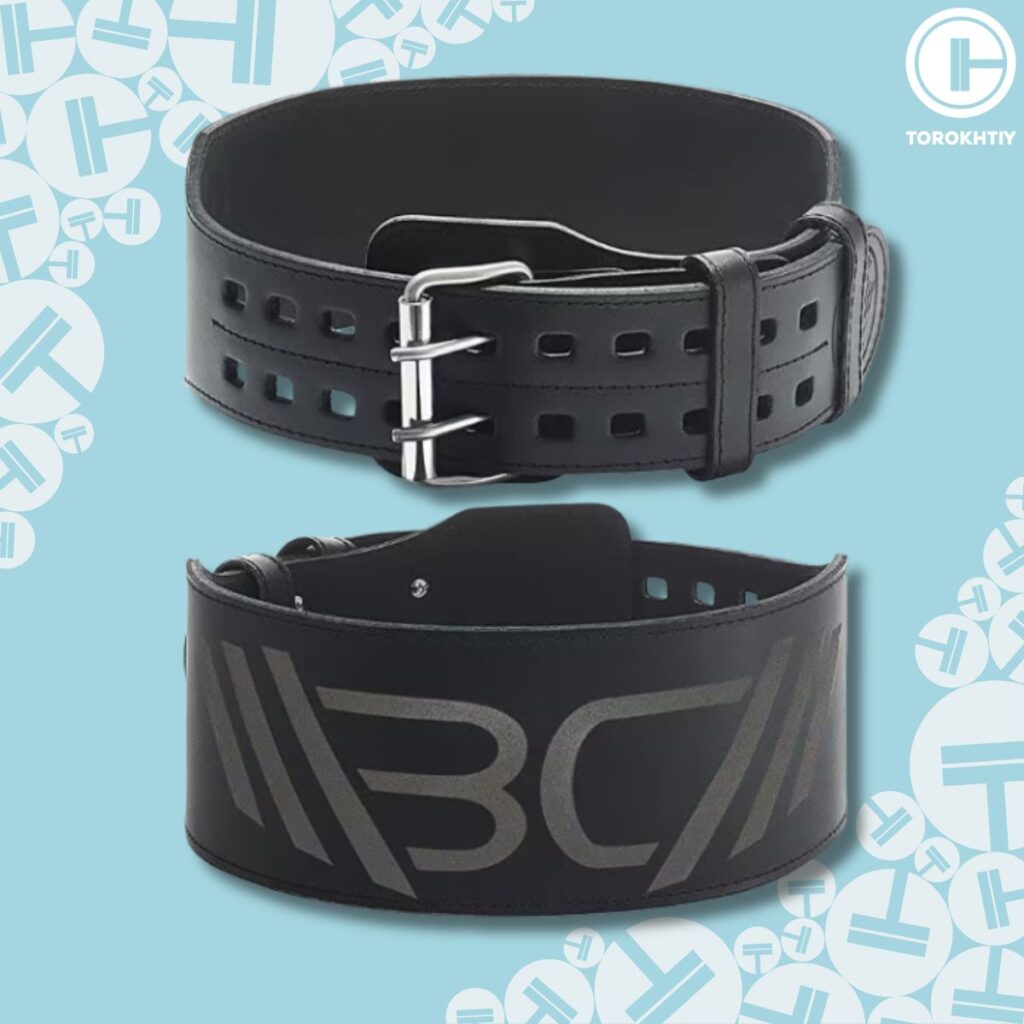
Still have questions after reading our article? Unlock your full potential by engaging with our experts and community! Don’t hesitate — leave a comment below and Ihor Shymechko will provide a personalized answer and insights to help you reach your goals.